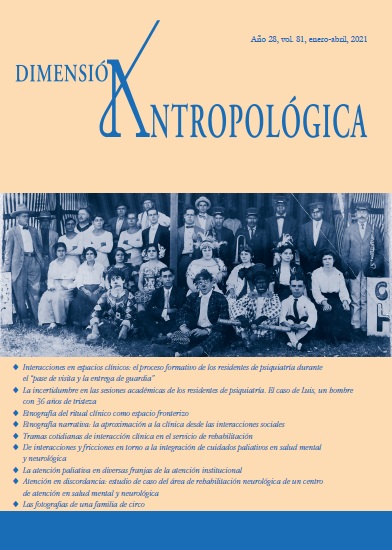Published 2021-04-30
Keywords
- Español
How to Cite
Abstract
Palliative care has become a necessary form of care, not only due to the aging of the population, but also due to the family, physical, social, economic, and emotional burden that chronic diseases represent. In Mexico, palliative care is necessary in biomedical care spaces, however, the reality in which palliative and curative care models interact is complex. One of the main problems in the implementation of timely palliative care is the lack of depth of medical education on these issues. The objective of this text is to carry out an interpretative analysis that, guided by on-site observations and interviews, accounts for the frictions, tensions, and emerging consensuses in social interactions between health personnel, people with neurological diseases and their families, root of the integration of palliative care in a Mental Health and Neurological Healthcare.
Downloads
References
- Ariès, Philippe, La historia de la muerte en Occidente. Desde la Edad Media hasta nuestros días, F. Carbajo y R. Perrin (trads.), Madrid, El Acantilado, 2005.
- Foley, Rose-Anna et al., “From Curative to Palliative Care: Confronting the New Medical Realities in a Hospitalised end of Life”, en Silvie Fainzang et al. (eds.), The Taste for Knowledge. Medical Anthropology Facing Medical Realities, Reino Unido, Aarhus University Press, 2010.
- Goffman, Erving, Frame Analysis. Los marcos de la experiencia, José Luis Rodríguez (trad.), Madrid, Siglo XXI, 2006.
- Gross, Sky, “Biomedicine Inside Out: An Ethnography of Brain Surgery”, Sociology of Health & Illness, vol. 34, núm. 8, 2012, pp. 1170-1183.
- Hamui, Liz, “¿Cómo analizar las narrativas del padecer? Construcción de una propuesta teórico-metodológica”, Revisa conamed, vol. 21, núm. extra 2, México, 2016, pp. 60-65.
- Harding, Sandra, “Is There a Feminist Method?”, en Sandra Harding (ed.), Feminism and Methodology, Bloomington / Indianapolis, Indiana University Press, 1987.
- Joas, Hans, “Interaccionismo simbólico”, en A. Giddens y J. Turner (comps.), La teoría social hoy, México, Alianza Editorial / Conaculta, 1991, pp. 112-154.
- Mattingly, Cheryl y Linda C. Garro, Narrative and the Cultural Construction of Illness and Healing, University of California Press, 2000, pp. 1-49.
- OMS, Cuidados paliativos, 2018, recuperado de: [https://www.who.int/es/news-room/fact-sheets/detail/palliative-care].
- Ritzer, George, Teoría sociológica moderna, 5ª ed., México, Mc Graw Hill, 2002.
- Sánchez, José, Un clamor de voces. Dialogismo y narrativas del riesgo en Molango, México, CIESAS, 2014.
- Secretaría de Gobernación, “Decreto por el que se reforma y adiciona Ley General de Salud en Materia de Cuidados Paliativos”, Diario Oficial de la Federación, 5 de enero de 2009.
- Secretaría de Salud, “Norma Oficial Mexicana NOM-011-SSA3-2014, Criterios para la atención de enfermos en situación terminal a través de cuidados paliativos”, Diario Oficial de la Federación, 9 de diciembre de 2014.
- Trujillo, Zoila, “Introducción”, en Zoila Trujillo et al. (eds.), Guía general de cuidados paliativos para el personal de salud, Secretaría de Salud-INNN, 2014.
- Trujillo, Zoila et al., “Estudio piloto en cuidadores de pacientes con enfermedades neurológicas, sobre el significado y conocimiento de cuidados paliativos”, Acta Bioethica, vol. 21, núm. 2, 2015, pp. 191-198.
- ____________, “Investigación sobre cuidados paliativos en México. Revisión sistemática exploratoria”, Revista Mexicana de Neurociencia, vol. 19, núm. 2, 2018, pp. 74-85.
- Van der Geest, Sjaak y Kaja Finkler, “Hospital Ethnography: Introduction”, Social Science and Medicine, vol. 59, núm. 10, 2004, pp. 1995-2001.

